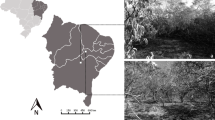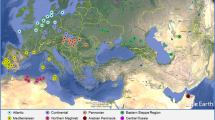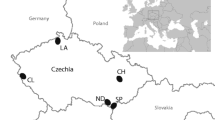Summary
The major food ofCamponotus detritus throughout the year was found to be honeydew excreted by aphids and scale insects present on the perennial vegetation in the dune habitat. This was supplemented by pollen, nectar, dead animal material and possibly bird and lizard faeces. Moisture was obtained from honeydew as well as directly from condensed fog water and occasional rain. The gasters of workers were capable of considerable distention, allowing them to take up from 48–84% of their body weight in liquid. Workers generally foraged individually, although recruitment to new food sources was sometimes observed. No food stores were found.
Resume
La nourriture principale deC. detritus au cours de l'année consiste en exsudats sucrés d'Homoptères présents sur la végétation pérenne des dunes. Cette nourriture est complétée par du pollen, du nectar, des débris d'animaux morts et, peut-être, des fèces d'oiseaux et de lézards. L'eau nécessaire à la vie des fourmis est obtenue à partir du miellat, de l'eau de condensation des brouillards et, de temps à autres, des pluies. Les gastres des ouvrières sont capables d'une grande tension leur permettant d'absorber de 48 à 84% de leur poids en liquide. Le plus souvent les ouvrières récoltent individuellement, une certaine collaboration dans la collecte de nouvelles ressources alimentaires ayant parfois été observée. On n'a jamais localisé de réserves dans les nids.
Similar content being viewed by others
References
Ayre G.L., 1963. — Laboratory studies on the feeding habits of seven species of ants.Can. Entomol., 95, 712–715.
Bernard F., 1960. — Notes écologiques sur diverses fourmis sahariennes.Trav Inst. Rech. Sahariennes Univ. Alger, 19, 51–63.
Burns D.P., 1973. — The foraging and tending behaviour ofDolichoderus taschenbergi (Hymenoptera, Formicidae).Can. Entomol., 105, 97–104.
Chew R.M., 1977. — Some ecological characteristics of the ants of a desert shrub community in southeastern Arizona.Am. Nat., 98, 33–49.
Curtis B.A., 1983. — Behavioural and physiological ecology of the Namib Desert dune ant,Camponotus detritus Emery. Unpubl. M.Sc. thesis, University of Cape Town, R.S.A.
Hecht O. 1924. — Embryonalentwicklung und Symbiose beiCamponotus ligniperda.Z. S. Wiss. Zool. Leipzig, 22, 173–204.
Holm E., Scholtz, C.H., 1980. — Structure and pattern of the Namib Desert dune ecosystem at Gobabeb.Madoqua (Windhoek),12, 3–39.
Kolb G., 1959. — Untersuchung uber die kernverhaltnisse und morphologischen Eigenschaften symbiotischen Mikro-Organismen.Z. Morph. Oekol. Tiere, Berlin, 48, 1–71.
Lévieux J., 1975. — La nutrition des fourmis tropicales. I: Cycle d'activité et régime alimentaire deCamponotus solon (Forel) (Hymenoptera, Formicidae).Ins. Soc., 22, 381–390.
Lévieux J., Louis D., 1975. — La nutrition des fourmis tropicales. II: Comportement alimentaire et régime deCamponotus vividus (Smith) (Hymenoptera, Formicidae). Comparaison intragénérique.Ins. Soc., 22, 391–404.
Lilienstern M., 1932. — Beitrage zur Bakterium-Symbiose der Armeisen.Z. Morph. Oekol. Tiere, Berlin, 26, 110–134.
Louw G.N., Seely M.K., 1982. —Ecology of Desert Organisms, Longmans, London, 194 p.
Mahdihassan S., 1977. — The black antCamponotus compressus feeding on urea.J. Bombay Nat., Hist. Soc., 74, 197–199.
Sanders C.J., 1970. — The distribution of carpenter ant colonies in the spruce-fir forests of northwestern Ontario.Ecology, 51, 865–873.
Schmidt-Nielsen K., 1975. —Animal Physiology: Adaptations and Environment, Cambridge University Press, Cambridge, 699 p.
Tevis L., 1958. — Seeds.Ecology, 39, 695–704.
Whitford W.G., Depree D.J., Hamilton P., Ettershank G., 1981. — Foraging ecology of seed-harvesting ants,Pheidole spp., in a Chihuahuan Desert ecosystem.Am. Mid. Nat., 105, 159–167.
Author information
Authors and Affiliations
Rights and permissions
About this article
Cite this article
Curtis, B.A. The dietary spectrum of the namib desert dune antCamponotus detritus . Ins. Soc 32, 78–85 (1985). https://doi.org/10.1007/BF02233228
Received:
Accepted:
Issue Date:
DOI: https://doi.org/10.1007/BF02233228




